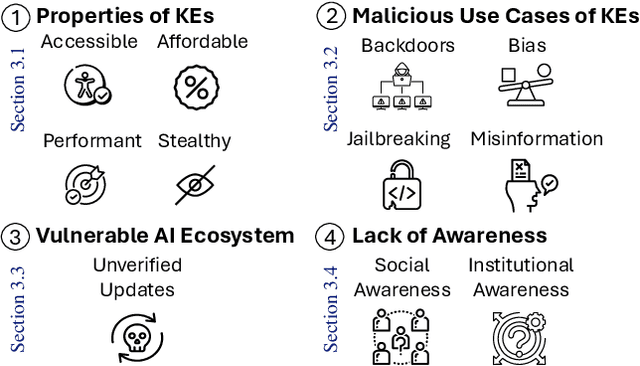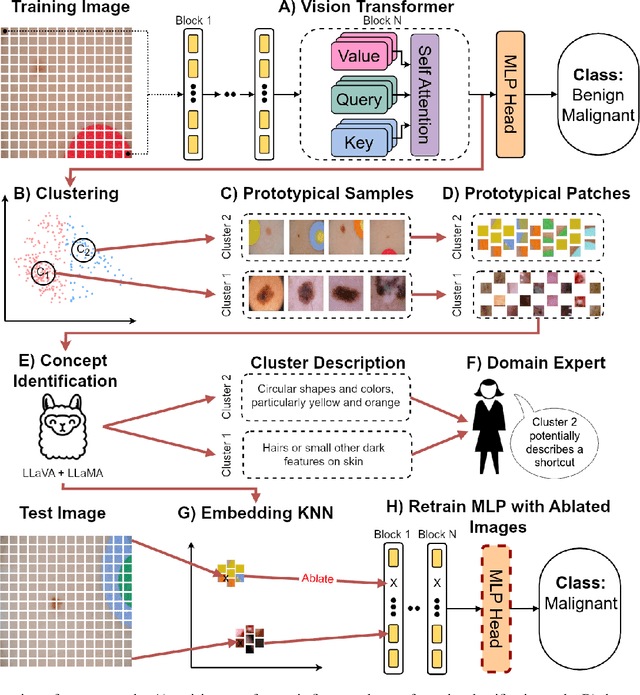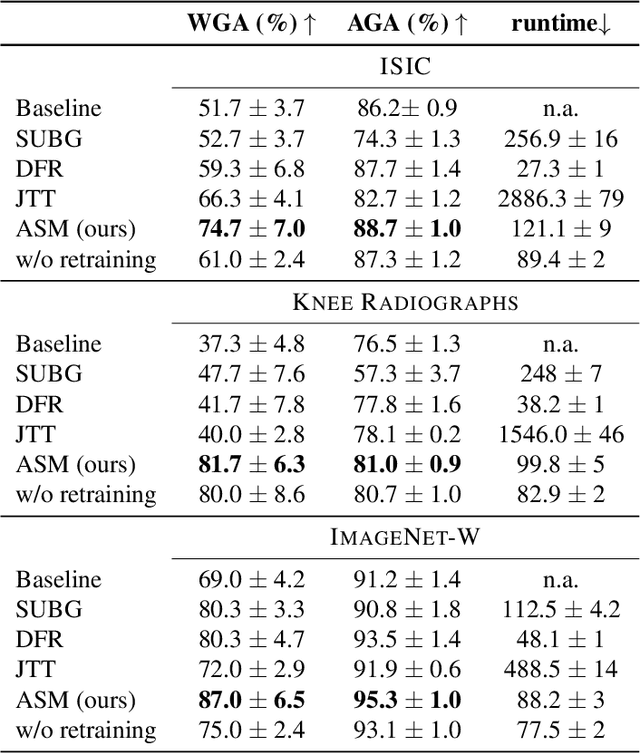Christin Seifert
Institute for Artificial Intelligence in Medicine, University Hospital Essen, Essen, Germany, University of Duisburg-Essen, Essen, Germany, Cancer Research Center Cologne Essen
Towards Interpretable Deep Neural Networks for Tabular Data
Sep 10, 2025Abstract:Tabular data is the foundation of many applications in fields such as finance and healthcare. Although DNNs tailored for tabular data achieve competitive predictive performance, they are blackboxes with little interpretability. We introduce XNNTab, a neural architecture that uses a sparse autoencoder (SAE) to learn a dictionary of monosemantic features within the latent space used for prediction. Using an automated method, we assign human-interpretable semantics to these features. This allows us to represent predictions as linear combinations of semantically meaningful components. Empirical evaluations demonstrate that XNNTab attains performance on par with or exceeding that of state-of-the-art, black-box neural models and classical machine learning approaches while being fully interpretable.
Tracing and Reversing Rank-One Model Edits
May 27, 2025Abstract:Knowledge editing methods (KEs) are a cost-effective way to update the factual content of large language models (LLMs), but they pose a dual-use risk. While KEs are beneficial for updating outdated or incorrect information, they can be exploited maliciously to implant misinformation or bias. In order to defend against these types of malicious manipulation, we need robust techniques that can reliably detect, interpret, and mitigate adversarial edits. This work investigates the traceability and reversibility of knowledge edits, focusing on the widely used Rank-One Model Editing (ROME) method. We first show that ROME introduces distinctive distributional patterns in the edited weight matrices, which can serve as effective signals for locating the edited weights. Second, we show that these altered weights can reliably be used to predict the edited factual relation, enabling partial reconstruction of the modified fact. Building on this, we propose a method to infer the edited object entity directly from the modified weights, without access to the editing prompt, achieving over 95% accuracy. Finally, we demonstrate that ROME edits can be reversed, recovering the model's original outputs with $\geq$ 80% accuracy. Our findings highlight the feasibility of detecting, tracing, and reversing edits based on the edited weights, offering a robust framework for safeguarding LLMs against adversarial manipulations.
Truth or Twist? Optimal Model Selection for Reliable Label Flipping Evaluation in LLM-based Counterfactuals
May 20, 2025Abstract:Counterfactual examples are widely employed to enhance the performance and robustness of large language models (LLMs) through counterfactual data augmentation (CDA). However, the selection of the judge model used to evaluate label flipping, the primary metric for assessing the validity of generated counterfactuals for CDA, yields inconsistent results. To decipher this, we define four types of relationships between the counterfactual generator and judge models. Through extensive experiments involving two state-of-the-art LLM-based methods, three datasets, five generator models, and 15 judge models, complemented by a user study (n = 90), we demonstrate that judge models with an independent, non-fine-tuned relationship to the generator model provide the most reliable label flipping evaluations. Relationships between the generator and judge models, which are closely aligned with the user study for CDA, result in better model performance and robustness. Nevertheless, we find that the gap between the most effective judge models and the results obtained from the user study remains considerably large. This suggests that a fully automated pipeline for CDA may be inadequate and requires human intervention.
Invariant Learning with Annotation-free Environments
Apr 22, 2025

Abstract:Invariant learning is a promising approach to improve domain generalization compared to Empirical Risk Minimization (ERM). However, most invariant learning methods rely on the assumption that training examples are pre-partitioned into different known environments. We instead infer environments without the need for additional annotations, motivated by observations of the properties within the representation space of a trained ERM model. We show the preliminary effectiveness of our approach on the ColoredMNIST benchmark, achieving performance comparable to methods requiring explicit environment labels and on par with an annotation-free method that poses strong restrictions on the ERM reference model.
An XAI-based Analysis of Shortcut Learning in Neural Networks
Apr 22, 2025



Abstract:Machine learning models tend to learn spurious features - features that strongly correlate with target labels but are not causal. Existing approaches to mitigate models' dependence on spurious features work in some cases, but fail in others. In this paper, we systematically analyze how and where neural networks encode spurious correlations. We introduce the neuron spurious score, an XAI-based diagnostic measure to quantify a neuron's dependence on spurious features. We analyze both convolutional neural networks (CNNs) and vision transformers (ViTs) using architecture-specific methods. Our results show that spurious features are partially disentangled, but the degree of disentanglement varies across model architectures. Furthermore, we find that the assumptions behind existing mitigation methods are incomplete. Our results lay the groundwork for the development of novel methods to mitigate spurious correlations and make AI models safer to use in practice.
Guiding LLMs to Generate High-Fidelity and High-Quality Counterfactual Explanations for Text Classification
Mar 06, 2025Abstract:The need for interpretability in deep learning has driven interest in counterfactual explanations, which identify minimal changes to an instance that change a model's prediction. Current counterfactual (CF) generation methods require task-specific fine-tuning and produce low-quality text. Large Language Models (LLMs), though effective for high-quality text generation, struggle with label-flipping counterfactuals (i.e., counterfactuals that change the prediction) without fine-tuning. We introduce two simple classifier-guided approaches to support counterfactual generation by LLMs, eliminating the need for fine-tuning while preserving the strengths of LLMs. Despite their simplicity, our methods outperform state-of-the-art counterfactual generation methods and are effective across different LLMs, highlighting the benefits of guiding counterfactual generation by LLMs with classifier information. We further show that data augmentation by our generated CFs can improve a classifier's robustness. Our analysis reveals a critical issue in counterfactual generation by LLMs: LLMs rely on parametric knowledge rather than faithfully following the classifier.
Behavioral Analysis of Information Salience in Large Language Models
Feb 20, 2025



Abstract:Large Language Models (LLMs) excel at text summarization, a task that requires models to select content based on its importance. However, the exact notion of salience that LLMs have internalized remains unclear. To bridge this gap, we introduce an explainable framework to systematically derive and investigate information salience in LLMs through their summarization behavior. Using length-controlled summarization as a behavioral probe into the content selection process, and tracing the answerability of Questions Under Discussion throughout, we derive a proxy for how models prioritize information. Our experiments on 13 models across four datasets reveal that LLMs have a nuanced, hierarchical notion of salience, generally consistent across model families and sizes. While models show highly consistent behavior and hence salience patterns, this notion of salience cannot be accessed through introspection, and only weakly correlates with human perceptions of information salience.
This looks like what? Challenges and Future Research Directions for Part-Prototype Models
Feb 13, 2025Abstract:The growing interest in eXplainable Artificial Intelligence (XAI) has prompted research into models with built-in interpretability, the most prominent of which are part-prototype models. Part-Prototype Models (PPMs) make decisions by comparing an input image to a set of learned prototypes, providing human-understandable explanations in the form of ``this looks like that''. Despite their inherent interpretability, PPMS are not yet considered a valuable alternative to post-hoc models. In this survey, we investigate the reasons for this and provide directions for future research. We analyze papers from 2019 to 2024, and derive a taxonomy of the challenges that current PPMS face. Our analysis shows that the open challenges are quite diverse. The main concern is the quality and quantity of prototypes. Other concerns are the lack of generalization to a variety of tasks and contexts, and general methodological issues, including non-standardized evaluation. We provide ideas for future research in five broad directions: improving predictive performance, developing novel architectures grounded in theory, establishing frameworks for human-AI collaboration, aligning models with humans, and establishing metrics and benchmarks for evaluation. We hope that this survey will stimulate research and promote intrinsically interpretable models for application domains. Our list of surveyed papers is available at https://github.com/aix-group/ppm-survey.
Position: Editing Large Language Models Poses Serious Safety Risks
Feb 05, 2025



Abstract:Large Language Models (LLMs) contain large amounts of facts about the world. These facts can become outdated over time, which has led to the development of knowledge editing methods (KEs) that can change specific facts in LLMs with limited side effects. This position paper argues that editing LLMs poses serious safety risks that have been largely overlooked. First, we note the fact that KEs are widely available, computationally inexpensive, highly performant, and stealthy makes them an attractive tool for malicious actors. Second, we discuss malicious use cases of KEs, showing how KEs can be easily adapted for a variety of malicious purposes. Third, we highlight vulnerabilities in the AI ecosystem that allow unrestricted uploading and downloading of updated models without verification. Fourth, we argue that a lack of social and institutional awareness exacerbates this risk, and discuss the implications for different stakeholders. We call on the community to (i) research tamper-resistant models and countermeasures against malicious model editing, and (ii) actively engage in securing the AI ecosystem.
Efficient Unsupervised Shortcut Learning Detection and Mitigation in Transformers
Jan 01, 2025



Abstract:Shortcut learning, i.e., a model's reliance on undesired features not directly relevant to the task, is a major challenge that severely limits the applications of machine learning algorithms, particularly when deploying them to assist in making sensitive decisions, such as in medical diagnostics. In this work, we leverage recent advancements in machine learning to create an unsupervised framework that is capable of both detecting and mitigating shortcut learning in transformers. We validate our method on multiple datasets. Results demonstrate that our framework significantly improves both worst-group accuracy (samples misclassified due to shortcuts) and average accuracy, while minimizing human annotation effort. Moreover, we demonstrate that the detected shortcuts are meaningful and informative to human experts, and that our framework is computationally efficient, allowing it to be run on consumer hardware.
 Add to Chrome
Add to Chrome Add to Firefox
Add to Firefox Add to Edge
Add to Edge